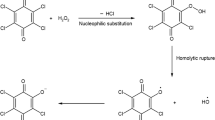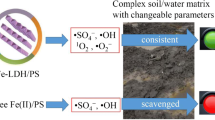Abstract
Production of hydroxyl radicals (•OH) upon the oxidation of solid Fe(II) by O2 or H2O2 in soils and sediments has been confirmed, which benefits in situ remediation of contaminants. However, Fe(III) reduction by H2O2 is rate-limiting. Accelerating the Fe(III)/Fe(II) cycle could improve the efficiency of remediation. This study intended to use hydroxylamine to promote Fe(III)/Fe(II) cycle during 100 g/L soil oxidation by H2O2 for phenol degradation. The removal of phenol was 76% in 3 h during soil oxidation with 1 mM H2O2 in the presence of 1 mM hydroxylamine but was negligible in the absence of hydroxylamine. Fe(III) in the soil was reduced to 0.21 mM Fe(II) by 1 mM hydroxylamine in 30 min. The accelerated cycle of Fe(III)/Fe(II) in the soil by hydroxylamine could effectively decompose H2O2 to produced •OH, which was responsible for the effective enhancement of phenol degradation during soil oxidation. Under the conditions of 1 mM H2O2 and 100 g/L soil, the pseudo-first-order kinetic constant of phenol degradation increased proportionally from 0.0453 to 0.0844 min−1 with the increase of hydroxylamine concentrations from 0.5 to 1 mM. The kinetic constant also increased from 0.0041 to 0.0111 min−1 with H2O2 concentration increased from 0.5 to 2 mM, while it decreased from 0.0100 to 0.0051 min−1 with soil dosage increased from 20 to 200 g/L. In addition, column experiments showed that phenol (10 mg/L) degradation ratio kept at about 48.7% with feeding 2 mM hydroxylamine and 2 mM H2O2 at 0.025 PV/min. Column experiments suggested an optional application of hydroxylamine and H2O2 for in situ remediation. The output of this study provides guidance and optional strategies to enhance contaminant degradation during soil oxidation.






Similar content being viewed by others
Availability of data and materials
The datasets used and/or analyzed during the current study are available from the corresponding author on reasonable request.
References
Buxton GV, Greenstock CL, Helman WP, Ross AB (1988) Critical-review of rate constants for reactions of hydrated electrons, hydrogen-atoms and hydroxyl radicals (•OH/•O-) in aqueous-solution. J Phys Chem Ref Data 17:513–886. https://doi.org/10.1063/1.555805
Chen CM, Hall SJ, Coward E, Thompson A (2020) Iron-mediated organic matter decomposition in humid soils can counteract protection. Nat Commun 11:2255. https://doi.org/10.1038/s41467-020-16071-5
Chen L, Ma J, Li X, Zhang J, Fang J, Guan Y, Xie P (2011) Strong enhancement on Fenton oxidation by addition of hydroxylamine to accelerate the ferric and ferrous iron cycle. Environ Sci Technol 45:3925–3930. https://doi.org/10.1021/es2002748
Chen LW, Li XC, Zhang J, Fang JY, Huang YM, Wang P, Ma J (2015) Production of hydroxyl radical via the activation of hydrogen peroxide by hydroxylamine. Environ Sci Technol 49:10373–10379. https://doi.org/10.1021/acs.est.5b00483
Cheng M, Zeng GM, Huang DL, Lai C, Xu P, Zhang C, Liu Y, Wan J, Gong XM, Zhu Y (2016) Degradation of atrazine by a novel Fenton-like process and assessment the influence on the treated soil. J Hazard Mater 312:184–191. https://doi.org/10.1016/j.jhazmat.2016.03.033
Du HY, Wang HX, Chi ZL et al (2021) Burst of hydroxyl radicals in sediments derived by flooding/drought transformation process in Lake Poyang. China Sci Total Environ 772:145059. https://doi.org/10.1016/j.scitotenv.2021.145059
Duesterberg CK, Waite TD (2007) Kinetic modeling of the oxidation of p-hydroxybenzoic acid by Fenton’s reagent: implications of the role of quinones in the redox cycling of iron. Environ Sci Technol 41:4103–4110. https://doi.org/10.1021/es0628699
Fukuchi S, Nishimoto R, Fukushima M, Zhu Q (2014) Effects of reducing agents on the degradation of 2,4,6-tribromophenol in a heterogeneous Fenton-like system with an iron-loaded natural zeolite. Appl Catal B 147:411–419. https://doi.org/10.1016/j.apcatb.2013.09.032
He DQ, Zhang YJ, Pei DN, Huang GX et al (2020) Degradation of benzoic acid in an advanced oxidation process: the effects of reducing agents. J Hazard Mater 382:121090–121098. https://doi.org/10.1016/j.jhazmat.2019.121090
He J, Yang X, Men B, Wang DS (2016) Interfacial mechanisms of heterogeneous Fenton reactions catalyzed by iron-based materials: a review. J Environ Sci 39:97–109. https://doi.org/10.1016/j.jes.2015.12.003
Hou XJ, Huang XP, Jia FL, Ai ZH, Zhao JC, Zhang LZ (2017) Hydroxylamine promoted goethite surface Fenton degradation of organic pollutants. Environ Sci Technol 51:5118–5126. https://doi.org/10.1021/acs.est.6b05906
Hou XJ, Shen WJ, Huang XP, Ai ZH, Zhang LZ (2016) Ascorbic acid enhanced activation of oxygen by ferrous iron: a case of aerobic degradation of rhodamine B. J Hazard Mater 308:67–74. https://doi.org/10.1016/j.jhazmat.2016.01.031
Katsoyiannis IA, Ruettimann T, Hug SJ (2008) pH dependence of Fenton reagent generation and As(III) oxidation and removal by corrosion of zero valent iron in aerated water. Environ Sci Technol 42:7424–7430. https://doi.org/10.1021/es800649p
Keenan CR, Sedlak DL (2008a) Factors affecting the yield of oxidants from the reaction of nanoparticulate zero-valent iron and oxygen. Environ Sci Technol 42:1262–1267. https://doi.org/10.1021/es7025664
Keenan CR, Sedlak DL (2008b) Ligand-enhanced reactive oxidant generation by nanoparticle zero-valent iron and oxygen. Environ Sci Technol 42:6936–6941. https://doi.org/10.1021/es801438f
Lai C, An ZW, Yi H, Huo XQ, Qin L, Liu XG, Li BS, Zhang MM, Liu SY, Li L, Fu YK, Zhou XR, Wang ZH, An N, Shi XX (2021) Enhanced visible-light-driven photocatalytic activity of bismuth oxide via the decoration of titanium carbide quantum dots. J Colloid Interface Sci 600:161–173. https://doi.org/10.1016/j.jcis.2021.05.022
Liao P, Yu K, Lu Y, Wang P, Liang YZ, Shi ZQ (2019) Extensive dark production of hydroxyl radicals from oxygenation of polluted river sediments. Chem Eng J 368:700–709. https://doi.org/10.1016/j.cej.2019.03.018
Li L, Liu SY, Cheng M, Lai C, Zeng GM, Qin L, Liu XG, Li BS, Zhang W, Yi Y, Zhang MM, Fu YK, Li MF, Long M (2022) Improving the Fenton-like catalytic performance of MnOx-Fe3O4/biochar using reducing agents: a comparative study. J Hazard Mater 406:124333. https://doi.org/10.1016/j.jhazmat.2020.12433
Lorenzo D, Dominguez CM, Santos RA, A, (2019) Wet peroxide oxidation of chlorobenzenes catalyzed by goethite and promoted by hydroxylamine. Catalysts 9:124333. https://doi.org/10.3390/catal9060553
Matta R, Hanna K, Chiron S (2007) Fenton-like oxidation of 2,4,6-trinitrotoluene using different iron minerals. Sci Total Environ 385:242–251. https://doi.org/10.1016/j.scitotenv.2007.06.030
Paciolla MD, Kolla S, Jansen SA (2002) The reduction of dissolved iron species by humic acid and subsequent production of reactive oxygen species. Adv Environ Res 7:169–178. https://doi.org/10.1016/S1093-0191(01)00129-0
Pham AL, Doyle FM, Sedlak DL (2012) Kinetics and efficiency of H2O2 activation by iron−containing minerals and aquiferials. Water Res 46:6454–6462. https://doi.org/10.1016/j.watres.2012.09.020
Qiu S, He D, Ma JX, Waite TD (2015) Kinetic modeling of the electro-Fenton process: quantification of reactive oxygen species generation. Electrochim Acta 176:51–58. https://doi.org/10.1016/j.electacta.2015.06.103
Schaefer CE, Ho P, Berns E, Werth C (2018) Mechanisms for abiotic dichlorination of trichloroethene by ferrous minerals under oxic and anoxic conditions in natural sediments. Environ Sci Technol 52:13747–13755. https://doi.org/10.1021/acs.est.8b04108
Tamura H, Goto K, Yotsuyanagi T, Nagayama M (1974) Spectrophotometric determination of iron (II) with 1, 10-phenanthroline in the presence of large amounts of iron(III). Talanta 21:314–318. https://doi.org/10.1016/0039-9140(74)80012-3
Tong M, Yuan SH, Ma SC, Jin MG, Liu D, Cheng D et al (2016) Production of abundant hydroxyl radicals from oxygenation of subsurface sediments. Environ Sci Technol 50:214–221. https://doi.org/10.1021/acs.est.5b04323
Viollier E, Inglett PW, Hunter K, Roychoudhury AN, Van Cappellen P (2000) The ferrozine method revisited: Fe(II)/Fe(III) determination in natural waters. Appl Geochem 15:785–790. https://doi.org/10.1016/S0883-2927(99)00097-9
Wang XB, Chen N, Liu XF, Shi YB, Ling CC, Zhang LZ (2021) Ascorbate guided conversion of hydrogen peroxide to hydroxyl radical on goethite. Appl Catal B 282:119558–119564. https://doi.org/10.1016/j.apcatb.2020.119558
Wei XY, Yi H, Lai C, Huo XQ, Ma DS, Du CY (2022) Synergistic effect of flower-like MnFe2O4/MoS2 on photo-Fenton oxidation remediation of tetracycline polluted water. J Colloid Interface Sci 608:942–953. https://doi.org/10.1016/j.jcis.2021.10.033
Welch KD, Davis TZ, Aust SD (2002) Iron autoxidation and free radical generation: effects of buffers, ligands, and chelators. Arch Biochem Biophys 397:360–369. https://doi.org/10.1006/abbi.2001.2694
Wu XL, Gu XG, Lu SG, Qiu ZF, Sui Q, Zang XK, Miao ZW, Xu MH (2015) Strong enhancement of trichloroethylene degradation in ferrous ion activated persulfate system by promoting ferric and ferrous ion cycles with hydroxylamine. Sep Purif Technol 147:186–193. https://doi.org/10.1016/j.seppur.2015.04.031
Xie WJ, Yuan SH, Tong M, Ma SC, Liao WJ, Zhang N, Chen CM (2020) Contaminant degradation by •OH during sediment oxygenation: dependence on Fe(II) species. Environ Sci Technol 54:2975–2984. https://doi.org/10.1021/acs.est.9b04870
Xie WJ, Zhang P, Liao WJ, Tong M, Yuan SH (2021) Ligand-Enhanced electron utilization for trichloroethylene degradation by •OH during sediment oxygenation. Environ Sci Technol 55:7044–7051. https://doi.org/10.1021/acs.est.1c00136
Yan N, Zhong H, Brusseau ML (2019) The natural activation ability of subsurface media to promote in-situ chemical oxidation of 1,4-dioxane. Water Res 149:386–393. https://doi.org/10.1016/j.watres.2018.11.028
Yang M (1999) Indirect spectrophotometry of hydroxylamine hydrochloride. Chem Eng Prog 16:233–235. https://doi.org/10.16229/j.cnki.issn1001-7542.1999.03.008 ((In Chinese))
Zou J, Ma J, Chen L, Li X, Guan Y, Xie P, Pan C (2013) Rapid acceleration of ferrous iron/peroxymonosulfate oxidation of organic pollutants by promoting Fe(III)/Fe(II) cycle with hydroxylamine. Environ Sci Technol 47:11685–11691. https://doi.org/10.1021/es4019145
Acknowledgements
We would also like to thank the sampling helped by Sicong Ma (China University of Geoscience, China).
Funding
This work was supported by the Ministry of Science and Technology of China (No. 2018YFC1802504) and the National Natural Science Foundation of China (No. 42107086). Ministry of Science and Technology of China,NO. 2018YFC1802504,Songhu Yuan,National Natural Science Foundation of China,42107086,Wenjing Xie
Author information
Authors and Affiliations
Contributions
Yunsong Zheng: experiments, formal analysis, investigation, writing-original draft. Wenjing Xie: investigation, formal analysis, data curation, writing-review and editing. Songhu Yuan: conceptualization, supervision, funding acquisition, resources, review and editing. All authors read and approved the final manuscript.
Corresponding author
Ethics declarations
Ethics approval and consent to participate
Not applicable.
Consent for publication
Not applicable.
Competing interests
The authors declare no competing interests.
Additional information
Responsible Editor: Kitae Baek
Publisher's note
Springer Nature remains neutral with regard to jurisdictional claims in published maps and institutional affiliations.
Supplementary Information
Below is the link to the electronic supplementary material.
Rights and permissions
About this article
Cite this article
Zheng, Y., Xie, W. & Yuan, S. Hydroxylamine promoted Fe(III) reduction in H2O2/soil systems for phenol degradation. Environ Sci Pollut Res 29, 30285–30296 (2022). https://doi.org/10.1007/s11356-021-18345-x
Received:
Accepted:
Published:
Issue Date:
DOI: https://doi.org/10.1007/s11356-021-18345-x




